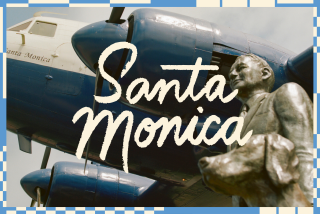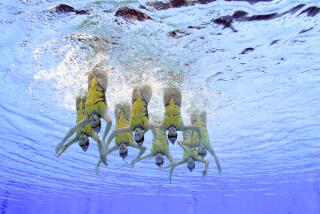Santa Monica paddleboard race recalls the sport’s local origins
For a few hours Saturday it was the 1930s again at the beach, as scores of men and women standing atop paddleboards glided across the calm waters outside the shore break.
The second annual Santa Monica Pier Paddleboard Race & Ocean Festival was a celebration of a sport that faded from view in the 1960s but has been revived in recent years by new technologies and star-powered marketing.
“With the evolution of the short board and leashes, it was the La Brea Tar Pits for any kind of long board — you’re dinosaurs, throw ‘em in the tar pits!” said Jericho Poppler, 59, a former world championship surfer. “Paddleboarding never went extinct, but it stayed parochial and remained a part of lifeguarding.”
Long before Gidget and the Beach Boys heralded the golden age of surfing, a group of Santa Monica lifeguards created the golden age of paddleboarding. In the 1930s and ‘40s they built wood boards inspired by aircraft wings and, piloting the boards with nothing more than their arms, competed in organized races to Santa Catalina Island.
Those pioneers — Tom Blake, Pete Peterson, Wally Burton and others — did for traditional paddleboarding what Laird Hamilton has recently done for big wave surfing.
Today, instead of lying flat on their chests and using their arms, those who embrace the modern version of paddleboarding stand upright and coast with the aid of a long paddle.
“There’s been a resurgence, and it’s now one of the fastest-growing sports in the nation,” said Todd Roberts, an organizer of Saturday’s event, which was also a fundraiser for the Santa Monica-based nonprofit Heal the Bay.
“You can do it in a lake. You can do it in a river or in a flat-water marina. You don’t need the ocean,” he said. “Once people try it and see how much easier it is than surfing, they get hooked.”
An exhibit of vintage boards at the pier highlighted the difference between then and now.
A 15-foot wood paddleboard on display that was once owned by Peterson weighed 80 pounds when it was built in 1936. Hollowed out and modified several times through the years, it’s now 38 pounds and still seaworthy.
“If they still weighed 80 pounds, nobody would be doing it,” said Jim Mollica Sr., who got the board from Peterson in 1959 to settle a $300 debt.
Lightweight, top-of-the-line boards cost more than $2,000. A 9-foot-long carbon-fiber paddle weighing just 16 ounces can set you back $399.
Equipment and cost aside, Saturday’s homage to the endurance of the paddleboard was, in many ways, a salute to the tradition of the waterman — an approach to life lived in the water that stretches back to the lifeguards of the 1930s and beyond.
“A surfer knows how to surf. A waterman knows kite surfing, wind surfing, longboarding, short boards, scuba diving, spear fishing.... Paddleboarding is part of it,” said former pro surfer Allen Sarlo, 53. “A waterman knows the water. He understands the life of the ocean.”
More to Read
Sign up for Essential California
The most important California stories and recommendations in your inbox every morning.
You may occasionally receive promotional content from the Los Angeles Times.










